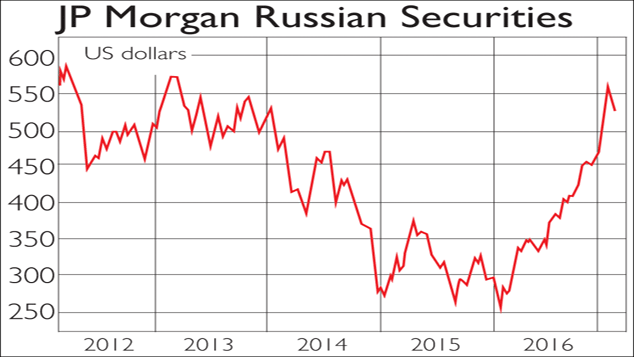What to take with you in the investment jungle
Both inflation and growth are picking up – and that’s a “jungle” for investors. Charlie Morris explains what you should buy now.


Both inflation and growth are picking up and that's a "jungle" for investors. Charlie Morris explains what you should buy now.
Much of economics is common sense. It is an attempt to better understand and predict our spending habits. But economic models typically fail, because accurately forecasting human behaviour is somewhere between tricky and impossible. That's not to say that human behaviour is random it's clear to anyone with any investing experience that different asset classes, geographies and sectors respond to changing economic environments in relatively predictable ways.
But it's better to use broad analogies to analyse this, rather than fall for the false precision of equation-based models. I have found one particular analogy very helpful in working out where we are in the economic cycle, and what it means for my own and my clients' money. Below, I'll talk you through it and explain exactly why, right now, I think we're in the "jungle".
MoneyWeek
Subscribe to MoneyWeek today and get your first six magazine issues absolutely FREE

Sign up to Money Morning
Don't miss the latest investment and personal finances news, market analysis, plus money-saving tips with our free twice-daily newsletter
Don't miss the latest investment and personal finances news, market analysis, plus money-saving tips with our free twice-daily newsletter
The money map and how to use it
When it comes to "big picture" economics, you can boil it down to two key forces inflation, and interest rates (or bond yields), which in turn tend to move with economic growth. In the "money map" diagram on the following page, inflation is on the y-axis, bond yields are on the x-axis, and I've used the analogy of money as water to describe the four different economic environments this gives rise to. You've got the jungle, where conditions are hot (inflation is high) and steamy (growth is strong too). You've got the desert, which is hot (high inflation too) but dry (growth is weak). Meanwhile, the grasslands are cool (inflation is low) but wet (strong growth), while the ice cap is cold (low inflation) and the water is locked up in ice (weak growth).
How do these two dimensions inflation and growth affect your investment decisions? Well, let's say that inflation in the UK is high. As a result, the pound will lose its future purchasing power, which makes UK assets less attractive. One answer for a British investor would be to invest overseas, in a country where inflation is stable. Or you could opt for "real" assets ones whose value tends to rise with inflation and so can shrug off a weakening pound. These include gold, commodities, inflation-linked bonds or property.
If inflation in the UK is low, on the other hand, the pound in your pocket is stable gilts, UK corporate bonds (when inflation is under control, the fixed income paid by bonds looks appealing) or UK equities should work well.
But on top of that, you also need to consider the rate of economic growth. Growth reflects the desire to take risks, create jobs the general level of animal spirits in the economy. Just as growth in the environment is slow if water is hard to access, economic growth requires money to fuel it. This comes down to bank lending conditions, or what economists call "liquidity" how apt.
You also have to consider that this model applies to conditions in individual markets rather than the globe as a whole: inflation might be rising in some countries, but not in others. For example, in Russia and Brazil, inflation has fallen over the past year and their stockmarkets have surged. As inflation has cooled, confidence in both the rouble and the real has improved, and they have also been assisted by a supportive oil price. This pick-up in confidence has attracted international investors, and as a result, asset prices have risen in a positive feedback loop.
More recently, we've also seen improvements in the inflation outlook for South Africa, Turkey and Mexico. For each of these countries, there remain well-flagged political issues, and economic growth is slow. But while that means the drop in inflation isn't necessarily a "buy" signal for their equities, it may be one for their bonds. And when growth then starts to improve, you could take profits from the bonds, and switch to equities. So this concept isn't UK or US-centric. It should be applied to every country with a free-floating exchange rate.

What assets to buy, and when
So what should you be looking to invest in under each economic scenario?
Equities: broadly speaking, equities tend to do best during "grasslands" conditions, when inflation is stable, and the economy is growing. Growth stocks tend to lead the way. This can be most clearly observed in emerging markets, whose stockmarkets are often small and domestically focused, and so respond well to changes in domestic economic conditions. However, different types of equities may do better under different conditions.
For example, in the developed world, stockmarkets are usually far more diversified. The FTSE 100 has a great deal going on under the bonnet. There are quality or bond-like businesses, that deliver goods that we need (toothpaste, food, medicine) rather than want (caviar, Gucci, holidays). These would perform best during "ice cap" conditions at least relative to other companies.
The natural resources or industrial stocks (value shares) would respond well to "jungle" conditions. Meanwhile the technology, consumer discretionary or services stocks (growth) would be best off in "grasslands". And in "desert" conditions, you're best off owning gold stocks.
Bonds: bonds tend to benefit from "ice cap" conditions where inflation is falling and growth is slowing as investors seek safe havens. Falling inflation promotes currency stability and in an emerging market it can often be accompanied by currency appreciation just as we saw in Brazil and Russia last year. When a country issues its own currency, the yield on its bonds tends to reflect the level of economic growth, as Swedish economist Knut Wicksell has pointed out.
As a result, higher yields as we are seeing in the UK and the US imply that these economies are growing. (On the other hand, if a country issues debt denominated in a foreign currency or in euros, if it's a eurozone country then creditworthiness comes into play, because there's a chance the country will default.)
Rising inflation eats away at the "real" returns a bond investor receives, so bonds should be avoided when inflation picks up. But as growth subsides and inflation falls, bonds can be attractive as they are risk free, at least in their country's local currency, which means they can rise in value during adverse conditions. For example, US long bonds doubled in US dollar terms (including income paid out) from mid-2008 to just after the Brexit vote. Inflation-linked bonds, on the other hand, have similar characteristics to gold, and are most likely to thrive during "desert" conditions.
In the "jungle", consider emerging market local currency debt. Meanwhile, in "grasslands", high-yield bonds can do well too (because a background of healthy economic growth means they are less risky than in times of recession).
Commodities: commodities do best in "jungle" conditions when the economy is strong (bond yields are rising) and potentially even overheating (inflation is taking off too). Commodities are real assets and so work as an effective safe haven when your home currency is being eroded away by inflation. Of course, you shouldn't invest blindly examine the investment case for each commodity.
Platinum group metals, silver, base metals, energy and agriculture each have their distinctive quirks. Be wary of excessive speculation, over-supply and Malthusian stories about how the world is running out of stuff like lithium such stories accompany every commodity upturn and almost never turn out to be true. Equally, you don't have to buy the commodities themselves or even the producers you could instead invest in countries that are rich in these resources, as they will see their economies boom as consumers spend more, property prices rise, and foreign investors queue up for a piece of the pie.
Gold: gold is a safe haven, but unlike bonds, it performs best when inflation is rising, growth is slowing, and bond yields are falling (ie when "real" yields are falling). Gold shrugs off inflation because it is a real asset. It also likes falling yields, because when yields are falling, the fact that gold pays no income becomes less of a concern for investors.
Gold tends to outperform commodities under "desert" conditions because economic activity is slowing, but it's not so keen on "ice cap" conditions. For example, despite its safe haven status, gold still fell during the 2008 financial crisis (although it recovered much faster than most assets). That's because inflation slid alongside bond yields cash and bonds were the things to own then.
As I noted above, I believe that right now we're in the "jungle", with signs of both inflation and growth picking up although it also looks increasingly likely that we're merely trekking through it on our way to the "desert". Below, I look at what you should invest in to take advantage and how conditions might develop in the near future.
A tale of four bubbles
You can get a better grip on how different economic environments affect asset classes by considering the bubbles that have blown up under different conditions.
Grasslands tech stocks (2000): in 1999, "real" yields were rising in other words, US bond yields rose, while inflation was stable. Rising real interest rates attracted capital to the US, and as a result, the dollar soared and a bubble formed in growth stocks. The technology sector in particular soared to levels not seen since 1929.The bubble peaked in 2000, which coincided with a high in real yields.
Jungle value stocks (2008): between 2002 and 2008, commodities, emerging markets and value surged as both bond yields and inflation were rising.The situation reversed with the financial crash in 2008 yields and inflation both collapsed and "jungle" assets, including value stocks, suffered badly, whereas both growth and quality stocks held up well. (Value stocks are normally backed by tangible assets whereas growth stocks are typically backed by ideas.) Given the excessive level of asset-backed lending, 2008 is best described as a "jungle", or value, bubble.
Desert gold (2011): the "desert" is the opposite environment of the "grasslands" gold, the classic "desert" asset, hit a major low point at the height of the dotcom boom. Then, after 2000, real bond yields began to ease from their 4% peak. They spiked back up to 3% during the financial crisis as inflation fell, but soon collapsed to 0% as economic conditions began to resemble the "desert" inflation wasn't exactly surging, but it did recover, while bond yields continued to slide to levels once deemed impossible. The resulting collapse in real interest rates caused gold to surge to more than $1,900 an ounce. That was about 50% higher than it should have been (according to my calculations) a bubble, in other words.
Ice cap bonds (2016): following the peak in gold in 2011, investors scrambled for the next safe haven. Government bonds kept on giving despite historically low yields, which in many cases turned negative, while high-quality stocks outperformed too (although they were not as overvalued as bonds). A portfolio comprising higher-quality assets (and less cyclical or speculative ones) left all other strategies in its wake. This bubble in quality has now ended and we're still to see the fallout.
The appeal of emerging markets in the investment jungle
If you look at the diagram above, "jungle" and "ice cap" are opposites, as are "grasslands" and "desert". Right now, in the developed world, bond yields and inflation are both rising. That ought to mean we're in the "jungle", and so commodities, industrials, value stocks and emerging markets are attractive.
My favourite emerging markets are: South Africa, which you can play with the exchange-traded fund (ETF) iShares MSCI South Africa (LSE: SRSA); Russia use the JP Morgan Russian Securities Trust (LSE: JRS); and Chile buy US-listed Banco de Chile (NYSE: BCH). The brave could consider Mexico db x-trackers MSCI Mexico (LSE: XMEX) and Turkey db x-trackers MSCI Turkey (LSE: XDTK) which have attractively valued currencies. In commodities, I like platinum (ETFS Physical Platinum LSE: PHPT) and grains (ETFS Grains LSE: AIGG).

Also avoid the opposite quadrant the "ice cap" assets. You should still have some of your money in "desert" and "grasslands", but less than you'd have if it was their turn. For "grasslands", some emerging internet stocks look attractive: Russia's social network VK.Com (Mail.Ru Group London Int'l: MAIL) and search engine, Yandex (Nasdaq: YNDX) are particularly interesting, as is New Zealand's fast-growing cloud-based accountancy software firm, Xero (New Zealand: XRO). Meanwhile, for the desert, buy the gold miners ETFS Daxglobal Gold Mining (LSE: AUCP) or iShares Gold Producers (LSE: SPGP).
If the economy overheats, or growth disappoints, but inflation keeps rising, then the "jungle" will keep on heating up until there's a fire. Thereafter, inflation could remain high while growth slows just as happened in the 1970s. If that's the result, then reduce your exposure to both "grasslands" and "jungle" assets, make "desert" your biggest position (gold is already doing well), and buy some "ice cap" assets gilts, bunds or treasuries (they'll be cheap by then).
Charlie Morris is head of multi-asset at Newscape Group and the editor of The Fleet Street Letter.
Get the latest financial news, insights and expert analysis from our award-winning MoneyWeek team, to help you understand what really matters when it comes to your finances.
-
 Asia's new tiger economy: MoneyWeek Talks
Asia's new tiger economy: MoneyWeek TalksPodcast MoneyWeek's editor, Andrew van Sickle, speaks to Dragon Capital's Thuy-Anh Nguyen about Vietnam's remarkable rise
-
 How much do you need to earn to afford the average rent?
How much do you need to earn to afford the average rent?Rental growth is slowing and making rents more affordable for tenants, but what hwo much do you need to earn to afford the average UK rent?
